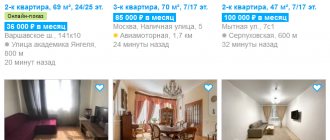You bought an apartment in a new building. It’s easier to do repairs this way, the house is new, there’s good infrastructure, and you’ll also be able to save money. Now the last step remains - to accept the finished work. But how to do it right? What should you pay attention to so that you can simply make a comprehensive renovation to your taste and not have to do the work for the developer, adjusting ventilation and leveling the walls? Now we'll tell you.
First actions
To ensure that your claims are not unfounded, read SNiP 3.04.01-87 in advance, which specifies the requirements for surfaces, door slopes, seams, plaster thickness and permissible deviation standards. It’s difficult to remember all the nuances; the document can be downloaded to a laptop that you take with you.
It is advisable to invite a specialist builder to the apartment in a new building or write down the phone number. In unclear situations, you can reset the photo and get advice.
Groups are created on social networks where shareholders of residential complexes communicate, describe the problems and deficiencies they encountered during the reception. After studying the information about claims, you will understand how to look for problem areas in the apartment.
Re-read, take with you the contract and project documentation, which indicates the area, finishing materials, partitions.
For your date with your new apartment, prepare a set of items and devices that will help during acceptance:
- a notepad is necessary for making notes and drawing up a list of shortcomings;
- lighter for checking ventilation, cracks in windows;
- A flashlight will help you look into dark corners;
- chalk or marker is needed to mark defects on surfaces;
- a laser rangefinder is needed to measure the curvature and area of surfaces (can be replaced with a tape measure, a rule, or a homemade plumb line made from a cord and a weight);
- an inexpensive electrical device for checking sockets;
- a rubber hammer to tap the screed and tiles;
- tester or light bulb for examining electrical wiring;
- stepladder for inspecting ceilings.
Important!
If the housing is on the first and last floor, the inspection begins with the basement and attic. Wet pipes and walls in the basement, damage to the roof will lead to dampness and unpleasant odors in the apartment.
Communication with future neighbors
Communities of developers, housing complexes and equity holders are often created on social networks. There you can see which of your future neighbors have already been to the inspection, and what shortcomings they found.
If there are a lot of defects, you can discuss this problem in a group, unite and write a collective complaint to the developer.
You can demand the developer to eliminate serious defects, or pay compensation to cover your costs of bringing the apartment into normal habitable condition. You are not obliged to accept an apartment where you cannot live.
Article 7 of the Federal Law of December 30, 2004 No. 214-FZ:
2. If a shared construction project is built (created) by a developer with deviations from the terms of the contract and (or) the mandatory requirements specified in Part 1 of this article, which led to a deterioration in the quality of such an object, or with other shortcomings that make it unsuitable for the intended purpose agreement of use, a participant in shared construction, unless otherwise provided by the agreement, at his own discretion, has the right to demand from the developer:
1) elimination of deficiencies free of charge within a reasonable time; 2) a proportionate reduction in the contract price; 3) reimbursement of their expenses for eliminating deficiencies.
3. In the event of a significant violation of the quality requirements for a shared construction project or failure to eliminate identified deficiencies within a reasonable period established by the participant in shared construction, the participant in shared construction unilaterally has the right to refuse to fulfill the contract and demand from the developer the return of funds and payment of interest in accordance with Part 2 of the article 9 of this Federal Law.
Window
Check the operation of the valves; they should open/close without creaks or clicks. Visible defects are not allowed in assembly seams, on the window block, or profile.
When you place your hand near the seal, you do not feel the movement of cold air. When opening the sashes, no friction is felt, the handles do not jam, and the window frame remains motionless.
Local area, common areas
What must be done before the house is handed over is written in the DDU and the project declaration.
Need to check
- Asphalt is laid around the house, there are no hatches sticking out
- Sidewalks are equipped, paving slabs are laid
- Lighting poles installed
- The elevators are working
- Lawns equipped
- There is light in the entrance
- Mailboxes installed
- Repair and finishing work in common areas has been completed
- Children's playgrounds are equipped and ready
Acceptance of utilities
The reliability of fastenings and the operability of all systems and equipment in the apartment are checked. You need to make sure that the seals on the meters are intact, take readings, and check for compliance with the serial numbers indicated in the passport.
Utility network survey
| System | Check what | |
| 1 | Water supply | Retaining mounting risers and vertical installation, sealing technical holes with mortar, operation of shut-off valves, water pressure |
| 2 | Sewerage | The presence of tees, the height of the pipe outlet. If the distance from the floor is more than 10 cm, problems may arise with the installation of plumbing. The standards do not indicate height, so check according to the project |
| 3 | Heating | Reliable fastening of risers and radiators, presence of thermostats. If a demonstration of battery operation is not carried out, it is necessary to make a note in the report |
| 4 | Ventilation | You need to bring a lighter or paper to the ventilation hole. If ventilation is good, the sheet sticks and the flame is deflected |
| 5 | Electrics | The functionality of the installed sockets is checked using an electrical appliance taken with you; light bulbs are screwed into the lampshades. The operation of the RCD is checked using the “test” button |
Advice from a sewer outlet inspection specialist
How to accept an apartment from a developer yourself
If you decide to rent an apartment in a new building without the help of an expert, you need to pay attention to every little detail. Regardless of the form in which the developer rents out the apartment (without finishing or with finishing), you need to accept it, be sure to check the following points:
- The entrance door must have a reliable design. It should open easily and close tightly.
- Seams and joints on the walls must be sealed according to all rules. There should be no visible traces of moisture at the junctions of building structures. Floor screed in an apartment should be handled with special care. You need to tap every meter of the screed with a hammer. If there are air bubbles in some places on the concrete screed, the sound from the impacts will be dull. Such areas should be outlined with chalk for fixation. Ideally, the concrete surface should be free of any cracks, but at the same time, the shrinkage characteristics of the building must be taken into account. Due to shrinkage, small cracks no more than 4 millimeters wide may appear on the surface of the screed. To check the horizontalness of the base for laying floors, a building level is used.
The same requirements apply to the ceiling as to the floor - horizontality and absence of cracks. According to BTI standards, the ceiling height should be 275 cm (the deviation from the vertical of wall structures should not exceed 5 mm over the entire height).
- Double-glazed windows of window structures must be tightly fixed in the frames. There should be no cracks on them. If the developer installs wooden frames, they must be free of knots and other defects. Seals on windows should not leave gaps for air to enter from the street. Window sashes should open and close easily.
- Before signing the transfer acceptance certificate, you must check the operation of the electricity . First, turn on the electricity supply to the apartment. Lighting is checked using a tester and an ordinary light bulb. In places where water meters are installed, the developer must install lamps to monitor the indicators. You can check the condition of the wiring by connecting powerful electrical equipment (for example, a hammer drill). The wiring must easily withstand frequent switching on/off of such a device.
- How to check the operation of water supply and sewerage ? Water metering devices are installed as close as possible to the riser so as not to occupy the useful space of the bathroom. The pipes must be covered with a layer of thermal insulation. Mixers and shut-off valves work without any complaints. The tees near the sink must be freely accessible for maintenance and repair. The toilet tank fills well with water, is kept hermetically sealed and is easy to drain.
- check the operation of the ventilation using a lighter held near the ventilation holes. If the ventilation is working properly, the flame will be deflected towards the vent. The same check can be done using a paper sheet. It should “stick” to the ventilation grille.
Acceptance of an apartment without finishing
The box contains communications, there are no partitions, slopes, plumbing, window sills, or plaster.
Must be:
- smooth rough screed without voids, bumps, crumbling;
- glazing;
- radiators;
- sewer line;
- electrical cable routing;
- water supply risers without wiring;
- outlets for heated towel rails;
- Entrance door;
- marking interior partitions;
- general house ventilation.
Walls
It is necessary to make sure that there are no foreign inclusions, pins, wires, and evaluate the curvature of the walls. A vertical deviation of 2 cm is allowed.
The video shows the easiest way to check verticality
There should be no gaps between panels and blocks or wet spots on the surface. Through gaps are considered a violation of construction standards. The brickwork must have identical seams without any influx of mortar or voids. The width of opposite walls is measured with a tape measure and compared.
Floor slabs
The slabs should not have rust stains, sagging, sinkholes 5 mm deep, cracks more than 2 mm that extend to the walls. A fine mesh with a width of 0.1 mm is allowed. In controversial situations, a study with special instruments and consultation with a specialist will be required, who will assess the condition of the structures, determine the causes and acceptability of cracks. The curtains must be carefully sealed with mortar. The permissible difference in ceiling height in different corners is no more than 1 cm.
Documentation
Read everything carefully. In the acceptance and inspection certificate, demand that phrases that do not suit you be removed. For example, a no claims clause if you want compensation for late payments.
The inspection report should not contain a clause stating that defects do not preclude the possibility of using the property for its intended purpose.
You should be given it in your hands
- A copy of the inspection report/defect report
- Original passport and warranty for the front door
- Original passport and warranty for windows
- Floor plan and explication
- Original passport for water, heating, electricity meters (meter numbers must match those in the passports)
- Cadastral passport of a real estate property
Need to check
- Power of attorney for the manager to sign the transfer and acceptance certificate on behalf of the developer (required with a stamp)
- If the apartment is transferred by a representative of the management company, then a copy of the document on acceptance of the object and utility networks of the management company
- A copy of the act of commissioning the facility
- A copy of the act of putting water, heating, electricity meters into operation
- A copy of the act on commissioning of the facility's engineering systems
Inspection of the apartment with pre-finishing finishing
The area must be prepared for the next renovation; window units, entrance and interior doors, radiators, and partitions must be installed.
The intermediate option involves minimal work:
- screed;
- plaster;
- plumbing and electrical wiring.
The bathroom must have waterproofing that extends to the walls above the screed, and wiring from the riser to future plumbing fixtures.
It is necessary to ensure that the joints at the pipe connections are tight. To level the floor, a concrete or cement screed is used. Large defects are visible without tools. The flatness of the coating is checked using a rule that is laid on the base and the gaps are visually determined. A laser level gives more accurate results. A deviation of 2 mm from the plane per 2 meters of length will allow you to lay rolled materials, parquet, and laminate.
A simple type of plaster consists of spraying the base and soil, which makes the surface even, almost smooth.
Permissible deviations
| Defect | Maximum deviation | |
| 1 | Irregularities (a rule is applied to determine) | Depth and height up to 5 mm |
| 2 | Number of irregularities in an area of 4 m2 | Up to 3 pieces |
| 3 | Horizontal difference along the entire length of the room | 15 mm |
| 4 | Difference in vertical area by 1m2 | 3 mm |
| 5 | Vertical deflection at full height | 15 mm |
You can see how the quality of plastering work is checked here
What typical defects are identified when accepting an apartment from a developer, and what to do in this case?
All new buildings have their own characteristics, and at almost every facility various deficiencies can be identified. To identify some of them, you will need the help of an expert. But there are also typical disadvantages of new apartment buildings, which you need to pay attention to first of all before accepting an apartment from the developer.
If you want to accept the apartment after eliminating the identified defects, you need to draw up an agreement with the developer indicating the exact deadline for completing the work. The fact is that Federal Law-214 does not define exact deadlines for eliminating deficiencies. After applying to the courts, calculations will be made to determine the average market duration of the necessary work.
If the development company does not complete the improvements within 45 days, then it should be guided by Article 20 of the Law on the Protection of Consumer Rights. An agreement to eliminate identified defects is drawn up in free form (preferably with notarization). This agreement must indicate the name of the developer's company, a list of claims and the work required to eliminate them. A copy of the inspection sheet must be attached to the document. If you want to accept the apartment after eliminating the identified defects, you need to draw up an agreement with the developer indicating the exact time frame for completion of the work. The fact is that Federal Law-214 does not define exact deadlines for eliminating deficiencies. After applying to the courts, calculations will be made to determine the average market duration of the necessary work.
If there is a significant defect, the shareholder sends an official notification to the developer (by mail or in person). The notice must indicate that the deficiencies must be corrected within 45 days, or the developer will be forced to return to the buyer the amount paid for the apartment and interest for the use of the shareholder’s finances. In addition to the inspection sheet, an expert’s opinion must be attached as a basis for reimbursement. This will help when considering the case in court.
Cooperating with is reliable and prestigious. The specialists working here are professionals of the highest level. operates throughout Moscow and the Moscow region.
What to look for in an apartment with a fine finish
The list of turnkey works and materials are specified in the contract and project documentation. It is necessary to check the brand of plumbing fixtures, building materials, windows, and doors.
The shareholder has the right to count on:
- neatly laid floor covering;
- decorative finishing of walls and ceilings;
- connected plumbing;
- installation of sockets and switches according to the project.
Quality of cladding installation
Vertical deviation of surfaces and perpendicularity are checked. There should be no defects or unevenness on the walls and ceiling. Panels and ceramic tiles are examined for the absence of cracks and chips, and the evenness of the seams. It is necessary to knock on the surface; a ringing sound will indicate the presence of voids. There should be no glue stains, cracks, pattern mismatches, or bubbles on the wallpapered wall. On painted surfaces, check for uniformity of color and texture, fluff, drips, and brush marks. If the floor is lined with laminate, parquet boards, you need to make sure that there are no gaps between the boards and deflections of the locks, and that there is a centimeter seam around the perimeter of the room.
When facing with linoleum, check the evenness of the joints of the panels, the absence of waves, raised edges, and swelling. Horizontality is checked with a rod; deviations from the plane are allowed up to 2 mm.
Acceptance certificate and defect report
If you have inspected the house and apartment and have no complaints about the quality of what you saw, you can sign the acceptance certificate. If there are any shortcomings, you have two options.
If the shortcomings are significant
- those in which it is impossible to live in the apartment - do not sign the acceptance certificate. Record all the shortcomings in the defective act, and be sure to emphasize that they are significant.
If the shortcomings are insignificant
, write them down in the defect report, and also sign the acceptance certificate.
You should not accept an apartment with significant shortcomings to avoid unnecessary problems. The developer, who has received a signed acceptance certificate from you, can then feed you “breakfast” for a very long time. As a result, you will have to go to court to defend your rights. And if you do not sign the acceptance certificate, the developer is interested in eliminating all defects and shortcomings as soon as possible in order to rent out the apartment to you.
Minor defects are not a reason to refuse to accept an apartment. This is when, for example, the walls are not completely straight, the windows are scratched or smeared - it’s ugly, of course, but it doesn’t interfere with life. If you do not sign the acceptance certificate in this case, after 2 months the developer will issue a unilateral transfer certificate and you will be responsible for the apartment. But he will have to prove that you are deliberately avoiding accepting the apartment.
Include non-essential defects in the defect report anyway. Such “little things” should not get away with careless developers. After all, when you signed a pre-employment contract, you were probably promised something brighter than scratched windows and crooked walls.
Checking the area of the apartment
It is necessary to measure the dimensions of each room and compare the results with the annex to the contract. There is a difference of several square centimeters in almost all new buildings. The permissible percentage of footage deviation is specified in the contract. The discrepancy between the designed and actual area occurs more often in monolithic and brick houses. If there is a discrepancy in size by more than 1 m2, a report is drawn up, the difference is canceled or the money paid is returned at the price specified in the DDU at the time of signing. If the area differs significantly from the design one, you may not accept the apartment and demand a refund.
How to accept an apartment from a developer under DDU
Since the apartment in the new building has not yet been used and completely new engineering communications have been laid here, it is necessary to carefully check their functionality. If this is not done, then life in a new apartment may be completely devoid of comfort. Let's take a closer look at how to accept a new apartment from a developer.
The specifics of the acceptance process depend on the type of finishing with which the property is being rented. There are three options:
- Apartments without finishing.
- Housing with rough finishing.
- Apartments with fine finishing.
How to accept an apartment from a developer without finishing? To do this you will need a measuring tape. It is necessary to make sure that the apartment fully complies with the project plan, which is attached to the DDU. Check the sizes of rooms, bathrooms, corridors, balconies and other premises. There are many examples when, when starting to accept an apartment, shareholders find out that it does not quite correspond to the project. If the actual area of the premises is less than that indicated in the DDU, then the developer must return part of the money to the owner of the apartment. And, conversely, the buyer will have to pay extra for the “extra” square meters.
If there is no finishing in the apartment, it will not be difficult to check the normal operation of doors and window systems, as well as take all the necessary measurements. After this, you need to check the presence of all the elements that are indicated in the DDU and the apartment plan. Particular attention should be paid to the following points:
- The walls should not deviate from the vertical. In this case, the screed should be level. There should be no signs of mold or mildew in the corners of the apartment.
- You should not accept an apartment that has broken double-glazed windows. The developer must make the replacement at his own expense. Likewise, he must replace/repair the broken door and lock or fix other defects. If there are serious deficiencies, the shareholder may not accept the apartment and demand that the developer return all funds paid, as well as pay a penalty.
- Checking the operation of the ventilation is carried out with a regular lighter.
- If the DDU specifies the presence of electrical sockets and light bulb sockets, their functionality also needs to be checked.
Next, we’ll look at how to accept an apartment from a developer for finishing. Acceptance of an apartment with rough (pre-finishing) finishing will require more time, since in this case it is necessary to check the quality of preparation for the final renovation (hanging wallpaper, laying flooring, etc.).
It is better to accept housing from a developer for finishing with an expert. A professional will be able to identify gross violations during construction work even during a visual inspection. To accept such housing, you need to inspect:
- Floors to check for the presence of a layer of waterproofing under the screed in the bathrooms (it is clearly visible, since it should extend slightly onto the walls). In other rooms, instead of a waterproofing layer, sound insulation is installed. Lack of heat and sound insulation is considered a gross violation. It is also necessary to check the absence of cracks, voids and differences in the screed using a building level.
- The walls in the apartment must be smooth and have a durable finishing layer of putty. There should be no voids, cracks or other defects on the surface of the walls.
- The ceiling surface must be well prepared for painting. This assumes the presence of plaster, which has been puttied and coated with a primer. After the pre-finishing of the apartment, work can be carried out in any direction of decorative finishing. It is also necessary to measure the height of the ceilings and compare the obtained indicators with the data indicated in the DDU. It is not allowed to lower the ceilings even by 10 mm.
- The heating system must be completely ready for operation. It is necessary that the pipes do not have dents, and the heating radiators are installed in the specified places and secured to at least three brackets. The batteries must be installed at a height of 60 mm from the floor level and at a minimum distance of 25 mm from the wall. In addition, it is necessary that the height from the radiator to the window sill be at least 5 mm. If you have to take over an apartment after the start of the heating season, then you need to check the availability and operation of thermostats.
- The risers for cold and hot water supply must be positioned strictly vertically. It is necessary to check the reliability of their fastening to the walls using clamps. The water consumption metering unit must include a filter for pre-purification of water, a tap and a meter. Check the operation of the shut-off valve and record the meter number and reading. Don't forget to open the sink faucet and check the presence of water and its pressure. Please also pay attention to the absence of rusty stains and mechanical damage on all faucets.
- The sewer riser must be positioned strictly vertically and securely fastened to the wall using clamps. Check the tightness of all joints connecting the bathtub and toilet.
- Ventilation is checked using a lighter or a piece of paper using the technology described above.
- The input electrical panel must be equipped with an automatic circuit breaker, RCD and load group switches. Be sure to write down the number and readings of your electric meter. After this, use special equipment to check the operation of switches and electrical sockets (you can use a phone charger to check). Sockets should not spark or heat up after connecting an electrical appliance. If you brought a light bulb with you, screw it into the socket. Don't forget to check the doorbell's operation.
- If the remote control system provides for connecting the apartment to the Internet, cable TV, intercom, etc., you should check the presence of cables and evaluate their quality (insulation integrity).
- To accept an apartment from a developer, you need to check the quality of installation of window systems and finishing of slopes. It happens that builders “forget” to install window sills, ebbs and other elements. It is necessary to check the ease of opening and tight fit of all opening doors, as well as the reliability of locks and hinges. All slopes must be flat, without curvature.
- Door structures must not have mechanical damage. Check the ease of opening the doors. An open door leaf should not close on its own.
We just have to consider how to accept a finished apartment from the developer. Clean finishing means that the owner of the apartment can bring in furniture and move in immediately. Therefore, the inspection of such housing should be especially thorough. You need to make sure the quality of the decorative finish, the serviceability of the electrical wiring, sockets and switches, and also check all the points that were noted in the description of how to accept an apartment from the developer with a rough finish.
All points cannot be checked visually, therefore, a special tool may be needed. To be more confident in the quality of the finish, we recommend inviting a specialist in tiling and wallpapering.
The share participation agreements specify the exact deadline for transferring the apartment to the shareholder. If this deadline is violated, the developer is obliged to pay a penalty. The date specified in the contract determines the deadline for obtaining permits for putting the apartment building into operation. If the document indicates, for example, the 1st half of the year XXXX, then the procedure for obtaining permission must be completed before the end of June XXXX. From this moment or from the date of issue of permission to put the house into operation, the countdown begins for the period during which equity holders must accept the apartments. The penalty can be calculated for each day of delay.
A situation is possible when the developer received permission to put an apartment building into operation, as they say, “at the last moment.” After this, the rush begins to draw up transfer and acceptance acts with shareholders. Despite such a rush, shareholders should not accept an apartment from the developer to the detriment of their own interests. Thus, if the owner of the apartment does not sign the acceptance certificate of the apartment indicating the list of deficiencies to be eliminated, then the deadline for the delivery of the object will not be met. This situation gives rise to demands for payment of a penalty.
Real Estate Blog
Useful publications and instructions for using a competent shareholder
Apartment redevelopment in 2021: what has changed
What is a smart home, how much does it cost and what is it for?
Apartment on the top floor: pros and cons
What can you do with a mortgaged apartment and under what conditions?
Why are contributions for major repairs rising, but housing continues to deteriorate?
What is included in the total area of the apartment
All developers All new buildings








